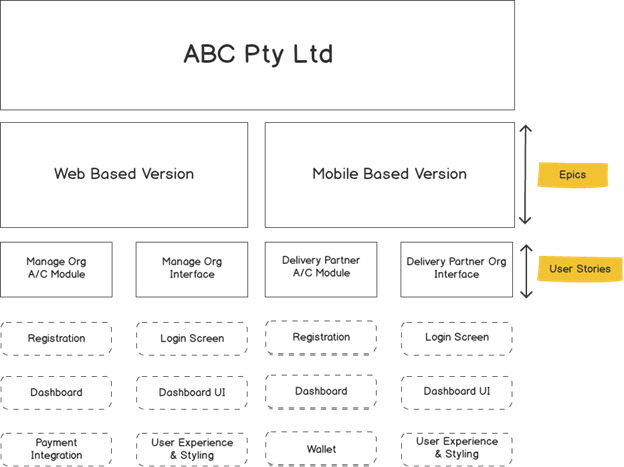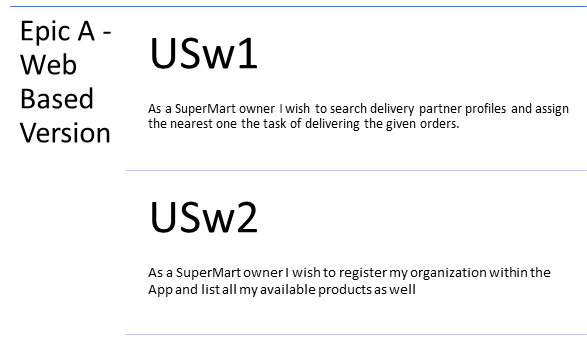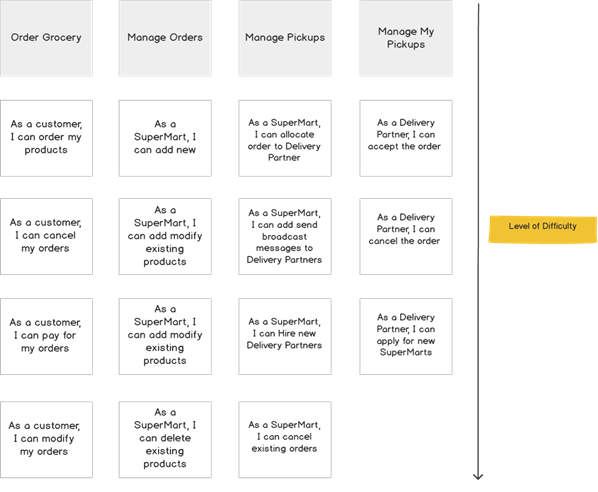Engineering Assignment: Online Delivery System Launch By ABC Pty Ltd
Question
Task:
Case Study
ABC Pty Ltd is a start-up tech company based in Adelaide Australia, who are currently seeking to develop an online delivery system named “ServicePlease”. The system aims to create a convenient platform to be used by service providers, customers, and supermarkets for home delivery of groceries to customer residents. The application will be available in both forms of website and mobile app, with separate views for service providers, supermarket, and customers. ABC Pty Ltd wants to launch this system to market in the next six months and have secured an investment for this. You have been hired by ABC Pty Ltd as the Business Analyst (BA) to help them with the requirement analysis for this project.
The “ServicePlease” application should provide the service providers to register with the system. During registration service providers will be asked to complete the background checking process. Criminal history or background will be checked through National Crime Check (NCC). Right – to – work will be checked through Visa Entitlement Verification Online (VEVO), which will confirm their citizenship, residency or visa status that allows them to work in Australia. All service providers will need to provide an Australian Business number (ABN), which will be checked through ABN Lookup. Service providers also need to give proof for delivery capability by car through driving license and vehicle registration certificate. Upon successful completion of registration, the service provider will be eligible and available for grocery delivery service in “ServicePlease”.
Supermarkets can register with “ServicePlease” online delivery system. When registered, customers will be able to find the supermarket in “ServicePlease” system. Supermarkets can accept and prepare an order to be picked up by the service provider authorized by a customer. The system should enable supermarkets to rate service providers and certify as their preferred one.
To use this service, resident customers need to sign-up first. Sign up can be verified with a valid mobile phone number and an email address. Customers need to set-up the payment method using credit card, debit card or PayPal, to pay for the service when used.
While ordering, the application should enable customers to search and select a supermarket first (pickup location). Then the customer needs to authorise a service provider from the available list (certified service providers will be shown at the top of this list, then based on rating) to pick up groceries from a selected supermarket and deliver to their residence (drop-off location). Once the job is completed, payment can be made securely through the app. Customer will get email confirmation after successful completion of an order. Customers also can rate and review the service provider, as well as the supermarket.
Engineering Assignment Task Summary
This final assessment requires you to respond to the given case study used in Assessment 1 and 2, so that you can develop insights into the different facets of Requirements Analysis in agile. In this assessment you are required to produce an individual report of 2000 words (+/-10%) detailing the following:
- A Product Roadmap for the project
- Product Backlog of coarse granularity including Epics and User stories
- Personas who typifies the future system end user
- Decomposition of Epics into User stories for first release
- Minimum Viable Product (MVP) definition for first release
- Story Mapping for MVP - ordering User stories according to priority and sophistication
- Story elaboration of User stories for MVP to ensure that the User story is clear, along with the acceptance criteria for the elaborated stories to ensure the ‘definition of done’.
- A paragraph detailing the similarities and differences between ‘traditional predictive’ and ‘Agile’ requirements analysis and management.
Answer
Background Of Engineering Assignment
Since its inception, the agile development had grown in popularity among programmers and software engineers alike. Self-organizing cross-functional teams collaborate to iteratively repeat the requirements as well as solutions until a desirable product output is reached in agile software development. DevOps, or "agile," As a result of this research, many elements of requirement analysis have been developed. First, we look at the product roadmaps, backlogs, and user story breakdowns for the first league. For the first edition, this paper examines the definition of a Minimum Viable Product (MVP), focusing on MVP Stories so as to make sure that now the user stories remain clear (Jiang, 2014). It will illustrate the elicitation methodologies, document analysis and capacity to sustain requirements in an organisational environment in the research report. As part of this effort, this paper will summarise the main concepts of managing requirements & collaborating with stakeholders to resolve challenges. An in-depth analysis of the company's sustainable business practises will be conducted following this research study.
Product RoadMap
Having a long-term goal and a short-
The Product Roadmap, as stated above, reflects the product's long-term ambition. Planning in product roadmap demonstrates the product's progress in the context of its features. The product roadmap is a visual representation of the product's trajectory, which is defined by its vision and strategy. There is no end in sight to a product's journey, however the Product Roadmap reflects the product's genesis and current level of success.
Desired Outcomes
We've agreed to create a Mobile and web app for ABC Pty Ltd as part of our contract. It is expected that the Product Roadmap would result in a four-quarter timeline depicting the whole year. Epics features are included in each quarter of the year. Time-bound User Stories are created from these epics. The Product Roadmap would be a list of all of the epics that have been created throughout the course of the product's progression, one epic for each quarter.
PRODUCT TEAM
Product development is generally connected with multiple groups of people, identified as Teams, who work together to create it. Each member of the team is assigned a certain position and a specific responsibility. It's customary for an Agile team to have a product sponsor, product team, Scrum Master as well as technical architecture group, which includes a mix of engineers with analysts (Narvel & Rane, 2021).
PRODUCT ROADMAP
ABC Pty Ltd's intended product is depicted in the following Product Roadmap. Since this caters to a wide range of consumers, Web development would be a high priority. The mobile app is created solely to guarantee that the app offers more functionality to the user than the Web application does.
|
Timeline |
Q1 |
Q2 |
Q3 |
Q4 |
|
Product Team |
||||
|
Product Sponsor |
|
|
|
|
|
Product Owner |
User Registration module |
|
|
|
|
ScrumMaster |
User Account Module |
Delivery Partner Module |
|
|
|
Development Team |
|
Organizational Module |
Alpha & Beta Release |
|
|
QA Team |
|
PCI Integration |
Unit Testing |
Web-based version Release |
|
Analytics |
|
|
A/B Test |
Mobile Application Development (iOS and Android) |
|
Stakeholders |
|
|
|
RC Release of the App |

Product Backlog
As a product backlog in an Agile setting, it is typically viewed as the most significant artefact. For a product or system, it's indeed essentially a list of all of its requirements and features. It might be referred to as a prioritised to-do list. For the purposes of this document, it serves as a list of the items that have been recognised for improvement and development in the future (Nicholas & Steyn, 2012). The business analyst as well as the company decide what work from the four product backlogs will be tackled next when preparing for a delivery augmentation, and this becomes the foundation for another package of work. It is possible to depict product backlogs manually, by making use of a task board comprising sticky notes, or even using some requirements management automated system (Parry & Lind, 2016). It is indeed good for groups that operate in direct range and need to see the backlog at the same time, therefore the first option is perfect. One of the most important aspects of such a product backlog is that everything is updated and revised on a regular basis to reflect new information and to keep pace with Agile development. It is alluded to as "grooming" the backlog as well as "maintaining" it.
Persona
Users' normal behaviour while interacting with a solution is modelled after fictitious characters called personas. There are several benefits to using personas to get insight into a certain user group, including their desires and objectives. In order to better understand user interface needs, personas are frequently employed. Users in this group can assist define usability as well as accessibility criteria by better understanding them (Rakovi, 2021). Using personas, a team which doesn't have easy accessibility toward a customer representative might gain a better understanding of their demands through the usage of personas. The work may then concentrate on the traits that are most important to a specific persona.
User Persona
Student Rony Mcarthy attends Brisbane's prestigious Queensland University. He is currently a sophomore in college. When he goes to school, he has to pay for his education. He has a couple of part-time jobs and plays music on the side. The previous three years have seen him working as an accomplice, a waiter, a chauffeur, and a security guard. He was a member of a well-known organisation and obtained top-notch training. In the future, he intends to seek out additional chances where he may both learn and earn. The purpose of utilising this system is to apply towards the available deliveries and then pick up and deliver the goods to the consumer. The user experience ought to be efficient and streamlined so that it doesn't bother the user and assists with orderly completion of all tasks.
Organization Persona
Farm-to-table fresh produce, such as organic fruits as well as vegetables, is available at FreshMart, a local supermart in the area. They have a vast selection of stocks and aggressively price each one. However, due to the organic nature of the items, they have a higher price tag and are less efficient to run. Using a logistics service provider might help them expand their business and achieve new heights (Vega & Aubry, 2018). They and other retailers like them want to put their stores mostly on system and administer them, as well as track and fulfil outstanding orders in their stores, before assigning a delivery partner to the order. They expect to have complete control over the system and a streamlined user interface that doesn't slow down their experience during peak hours of traffic.
Decomposition of Epics into 2 User Stories


Story Mapping and Minimum Viable Product
Story mapping is indeed a way to get a sense of how the system will work in the long run. When employing a backlog of tales, this helps to add context which might be lacking (Vega & Aubry, 2018). IT development projects aren't the only ones that benefit from narrative mapping. The narrative map depicted in the figure beneath shows user stories arranged in order of importance and complexity.

Once the story map is created it can be used to decide what should be built first. Some teams focus straight away on the first iteration, where others focus on a first release that will contain numerous iterations. The first deliverable may be an experimental prototype that is demonstrated to customers in order to test an idea or reduce a recognised risk. This is often referred to as a Minimum Viable Product (MVP) (Wang, Wood, Abdul-Rahman, & Lee, 2016). Feedback collected through the early deliverables will enable the customer and development team to learn from the process and create further user stories for future iterations and releases.
Story Elaboration
User story ID: UW01
On the ABC Pty website, I'm looking for people with the right abilities so that I may contact them and offer them work.
Priority: Must
Acceptance criteria:
• Searches should be able to be narrowed down by location of the courier person.
• The results of a matches must include the user's name and contact data.
User story ID: UW02
In my role as a SuperMart owner, I would like to send personalized advertising to individuals with suitable talents so that I may offer them jobs and explain the specifics.
Priority: Should
Acceptance criteria:
• It is essential that recruiters be able to send communications to individual delivery partners interesting in using the online site.
• Conversations should be saved so that recruiters can review them if needed.
User story ID: UM01
My goal is to use the ABC Pty mobile phone app to post my resume so that employers may check it and get in touch with me if they have a need for someone like me.
Priority: Must
Acceptance criteria:
• I must be able to pick from a pre-existing collection of locations in order to use this app..
• The app must allow me to choose location where I am available to work.
User story ID: UM02
As a student having completed the job, I want to securely receive online payment through ABC Pty app so that I can withdraw the money.
Priority: Must
Acceptance criteria:
• My banking details must be stored securely on the mobile app.
• Verification and encryption of the payment transaction are a need.
Agile vs Traditional Approach
In contrast to established frameworks, such as the Waterfall model, the Agile framework is built on adaptable software development approaches. There is no need for a lot of rigors preparation with the Agile process. Changes in product requirements necessitate frequent testing to prevent serious flaws from being introduced (Yang, 2012). In contrast, the traditional predictive strategy relies entirely on meticulous planning and extensive requirements assessment at the beginning of software development. All changes need strict change management and prioritising. Predictive approaches, on the other hand, often have well-developed requirements models in place prior to the execution and coding phase. Documentation like this can help software engineers while they're writing code. This ensures that the application is completed without disruption, then there's no need to worry about regular meetings or demonstrations to the customer (Zlokazov, 2020). In general perception, agile techniques employ high-level as well as low-ceremony requirements processes. Using agile methodologies, customers are actively involved in the process of gathering and refining requirements. All system engineers are engaged in requirements engineering, and everyone may and should contact with clients on a frequent basis (Narvel & Rane, 2021). The client is less involved in conventional methods once the software requirements has just been generated and accepted, and normally, the interaction is with the software engineers. The agile method to requirements engineering would presumably far more resistant to changes all throughout procedure than in conventional software engineering.
Conclusion
Adaptive as well as iterative application development methodologies like Agile are already commonly embraced. This has necessitated the development of new requirements analysis and management approaches and competences. ABC Pty Ltd's case study was used to demonstrate the applicability of these strategies. A Product Roadmap had been drawn up to help with the proposed application. This same Product Roadmap shows the list of items that will be implemented over the course of a quarter. Epics/Features also were known as these. Epics are represented in the Product Backlog, that will be broken down into User Stories with in future. It also includes Acceptance Criteria as well as Definition of done for the epics & user stories connected to the first version. User Stories & Epics have been mapped to that same Product Backlog utilizing Story Mapping just so the Minimum Viable Product may be achieved with a greater value. The Agile team may verify that the needed product is built in accordance with marketing needs by using the Product Roadmap as well as Backlog. The firm will be able to expand its business and engage more individuals with organisations who need it by utilising the benefits of Agile approach in software development including requirements engineering.
References
Jiang, J. (2014). The Study of the Relationship between Leadership Style and Project Success. American Journal of Trade and Policy, 1(1), 51. https://doi.org/10.15590/ajtp/2014/v1i1/54054
Narvel, Y., & Rane, S. (2021). Developing strategies to prioritize and mitigate the risks occurring in Project Management Practices (PMP) for an agile organization. International Journal of Productivity and Quality Management, 1(1), 1. https://doi.org/10.1504/ijpqm.2021.10037073
Nicholas, J. M., & Steyn, H. (2012). Project management for engineering, business, and technology. Abingdon, Oxon ; New York, Ny: Routledge.
Parry, V. K. A., & Lind, M. L. (2016). Alignment of Business Strategy and Information Technology Considering Information Technology Governance, Project Portfolio Control, and Risk Management. Engineering assignment International Journal of Information Technology Project Management, 7(4), 21–37. https://doi.org/10.4018/ijitpm.2016100102
Rakovi, R. (2021). Project of ISMS Implementation in Organization — Aspects and Practical Experiences. European Project Management Journal, 11(1), 20–30. https://doi.org/10.18485/epmj.2021.11.1.3
Vega, G., & Aubry, M. (2018). From the Editors Introducing Teaching Case Studies in Project Management Journal®. Project Management Journal, 49(1), 3–5. https://doi.org/10.1177/875697281804900101
Wang, C., Wood, L. C., Abdul-Rahman, H., & Lee, Y. T. (2016). When traditional information technology project managers encounter the cloud: Opportunities and dilemmas in the transition to cloud services. International Journal of Project Management, 34(3), 371–388. https://doi.org/10.1016/j.ijproman.2015.11.006
Yang, L.-R. (2012). Implementation of project strategy to improve new product development performance. International Journal of Project Management, 30(7), 760–770. https://doi.org/10.1016/j.ijproman.2011.11.005
Zlokazov, D. V. (2020). Project Management vs Systems Engineering Approach to Project Risks Management. KnE Engineering. https://doi.org/10.18502/keg.v5i3.6784












